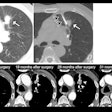Dear AuntMinnie Member,
CT is typically used as a first-line modality in cases of suspected appendicitis, but the modality's radiation burden can be a concern for children. Meanwhile, ultrasound has shortcomings of its own. Researchers from Arizona found that MRI can serve as an effective alternative, according to our most-read article from this past week.
A group from the University of Arizona used MRI as the initial imaging modality in more than 400 children, achieving "near perfect" accuracy. What's more, the vast majority of the scans did not require contrast enhancement.
Other important stories in our MRI Community this week include an article on the use of MR angiography screening for aneurysms related to kidney disease, and a new method using MRI to differentiate between Parkinson's disease and progressive supranuclear palsy. Another study used MRI to diagnose psychosis, while South Korean researchers developed an artificial intelligence algorithm to predict the progression of Alzheimer's disease.
Problems with breast thermography
Breast thermography has always been a technology operating on the margins of medical imaging. The U.S. Food and Drug Administration in the past has cleared thermography systems for use as adjuncts to screening mammography, but always with the caveat that they not be used on their own for screening.
That hasn't stopped the explosion of a cottage industry of standalone thermography centers -- of various shades of legitimacy -- that target women who want an "alternative" to mammography for breast imaging. This budding industry was the subject of a scathing report on "Good Morning America" that profiled the thermography industry, specifically focusing on two women with breast cancer -- one of whom died from the disease.
The segment illustrates the difficulty in cracking down on a market niche that uses pseudoscience to meet the emotional needs of women who are distrustful of mainstream medicine. Our coverage is available in our Women's Imaging Community.
Other important women's imaging stories this week include an article on how the combination of synthesized mammograms and digital breast tomosynthesis work well for breast screening, and four ways in which artificial intelligence can improve women's imaging by going beyond computer-aided detection.
Improving interventional radiology
Finally, new research out of Europe offers some intriguing suggestions for improving interventional radiology on the continent. Two European societies commissioned a survey to learn more about some of the difficulties facing the specialty -- difficulties that are remarkably similar on this side of the Atlantic.
We are looking forward to seeing many of our readers next week at the European Congress of Radiology (ECR) -- be sure to check our RADCast @ ECR starting on Wednesday for daily news from Europe's premier radiology conference.
See you in Vienna!



















